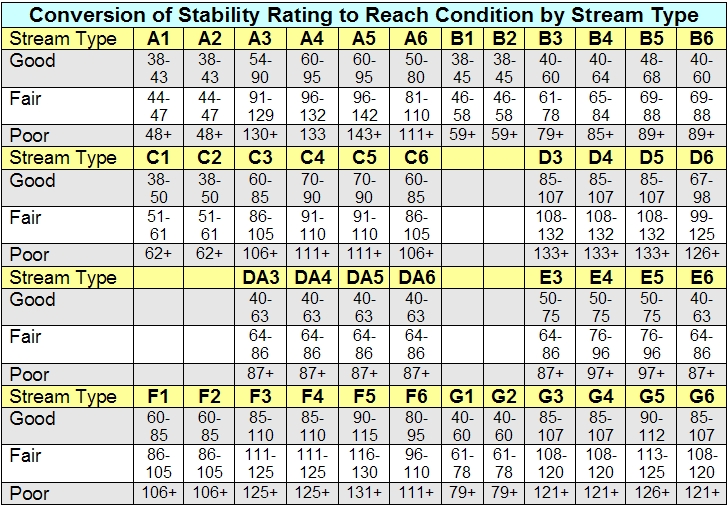
| glossary | menu | Normal | lg | hc | 8.) Rosgen Classification of Stability and Change > Explanation of the Pfankuch-Rosgen Stability Exercise |
| < Previous | 1 | 2 | 3 | 4 | 5 | 6 | 7 | 8 | 9 | 10 | 11 | 12 | 13 | 14 | 15 | 16 | 17 | 18 | 19 | 20 | 21 | 22 | 23 | Next > |
Explanation of the Pfankuch-Rosgen Stability Exercise

Exercise Objective
To assess Pfankuch-Rosgen channel stability rank given Stream characteristics.Exercise Explanation
- The described C3 river received the following Pfankuch-Rosgen scores:
- Upper Banks: Landform slope of 6, Mass wasting of 6, Debris jam potential of 3, Vegetative bank protection of 12.
- Lower Banks: Channel capacity of 2, Bank rock content of 4, Obstructions to flow of 4, Cutting of 4, Deposition of 8
- Bottom: Rock angularity of 3, Brightness of 2, Consolidation of particles of 4, Bottom size distribution of 12, Scouring and Deposition of 12, and Aquatic vegetation of 3.
- The Pfankuch-Rosgen numeric total score from the right hand column is 85.
- Conversion of Pfankuch-Rosgen numeric score to a C3 Reach condition resulted in a ranking of good, but at the outer limit and nearing fair.
Image modified courtesy of Rosgen
| < Previous | 1 | 2 | 3 | 4 | 5 | 6 | 7 | 8 | 9 | 10 | 11 | 12 | 13 | 14 | 15 | 16 | 17 | 18 | 19 | 20 | 21 | 22 | 23 | Next > |